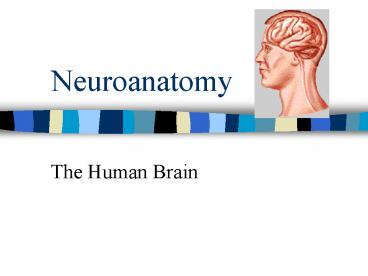Neuroanatomy - PowerPoint PPT Presentation
1 / 39
Title:
Neuroanatomy
Description:
Ventral- 'towards the stomach or bottom.' Anterior 'towards the front. ... Hippocampus 'seahorse' is the structure that lies in between the cortex ... – PowerPoint PPT presentation
Number of Views:215
Avg rating:3.0/5.0
Title: Neuroanatomy
1
Neuroanatomy
- The Human Brain
2
I. Directional Terms
- Dorsal- toward the back.
- Ventral- towards the stomach or bottom.
- Anterior towards the front.
- Posterior- towards the rear or back.
3
Terms contd.
- Rostral towards front nostrils.
- Caudal- towards the tail.
- Superior- top of head
- Inferior- bottom of head
- Lateral to the side
- Medial to the middle
- Ipsilateral same side
- Contralateral opposite side
4
Anterior view of brain
5
Posterior view of the brain
6
Lateral view of Right side of brain
7
Lateral view of Left Side of brain
8
Dorsal (Superior) view
9
Ventral (inferior) view
10
II. Brain Slices
- 1. Coronal slices brain from front to back.
Resembles a butterfly in most slices.
11
Brain slices (contd)
- 2. Sagittal (midsagittal) slices the brain down
the midline so you can see whats on each half.
12
Brain slices
- 3. Horizontal slices the brain from top to
bottom.
13
III. Planes of brain
14
IV. Cortical Landmarks
- 1. Gyrus (gyri) bulges on the brains surface.
- 2. Sulcus (sulci) a small ridge in the cortex.
- 3. Fissure (s) a large ridge in the cortex.
15
A. Gyri
16
B. Sulci-
- Central sulcus- separates frontal lobe from
parietal lobe.
17
C. Fissures-
- 1. Sylvian (Lateral Fissure)- Large ridge that
separates temporal lobe from other lobes.
18
Fissures (contd.)
- 2. Longitudinal fissure separates left right
hemispheres. - Left
Right
19
V. CNS PNS terms
- Nuclei cell bodies in the CNS.
- Ganglion cell bodies in the PNS
- Tracts Axon bundles in the CNS
- Nerves Axon bundles in the PNS
20
Terms contd.
- White matter composed of axon bundles. Is white
because of the myelin sheaths (white fatty
tissue) that cover the axons. - Gray matter composed of clusters of cell
bodies, have dark gray appearance from cell body
structures.
21
VI. Three Divisions of the Brain
- 1. Hindbrain oldest part of brain, governs
basic functions (breathing, regulates heart
beat). - 2. Midbrain involved in some perceptual
motor functions. - 3. Forebrain governs all higher-order level
functions (problem solving, planning, emotion
regulation, language).
22
VII. The Hindbrain-
- consists of the medulla, pons, cerebellum.
23
A. Medulla (oblongata)
- a structure just above spinal cord. Controls
regulates vital reflexes for survival
(respiration, HR, vomiting, salivation, coughing,
sneezing). - Damage to the
- Medulla is almost always
- fatal.
24
B. Pons
- An enlarged protrusion anterior to the medulla.
Both pons medulla form reticular formation
raphe system. - Plays a role in arousal dreaming.
25
C. Cerebellum (means little brain)
- Large hindbrain structure that is posterior to
the brainstem. - Governs motor functions, motor memory.
26
VIII. The Midbrain
- Most obvious feature is the tectum (roof).
- Two pairs of bumps on tectum
- Superior colliculi (vision)
- Inferior colliculi (audition)
- Substantia nigrapart of basal ganglia, involved
in movement (Parkinsons disease).
27
IX. The Forebrain
- Consists of subcortical and cortical structures.
- 1. Subcortical structures include the thalamus,
hypothalamus, limbic system, basal ganglia.
28
A. Thalamus-
- A large two-lobed structure that sits on top of
the brainstem. Is brains sensory relay station. - Several nuclei receive sensory input send that
input to parts of the cortex. - Nuclei Lateral geniculate nuceli (visual),
medial geniculate nuceli (auditory) ventral
posterior nuclei (somatosensory)
29
Thalamus
30
B. Hypothalamus
- Is ventral to the thalamus. Receives projections
from the fornix in its mammilary bodies. - Function regulation
- Of basic motivational
- Drives (sex, hunger,
- thirst, fighting).
31
C. Limbic system
- Comprised of the fornix, hippocampus, amygdala,
septum, cingulate gyrus.
32
Limbic system
- Fornix (arch) is the major pathway of the
limbic system projects in an arc from the
hippocampus into mammilary bodies of the
hypothalamus. - Hippocampus seahorse is the structure that lies
in between the cortex thalamus, rests in the
temporal lobe plays a large role in LTM storage.
33
Limbic system
- Amygdala almond lies anterior to the
hippocampus, is involved in basic emotions (fear,
anger).
34
2. Cortical structures-
- Lobes of the brain
35
(No Transcript)
36
Occipital lobe
- Most posterior portion of brain. Processes
visual sensory information. - Houses primary visual cortex (striate cortex).
- Damage to PVC can cause
- cortical blindness.
37
B. Parietal lobe
- Is posterior to the frontal lobe dorsal to
temporal lobe. Processes visual tactile
sensory information. - Houses primary
- Somatosensory cortex
- Which receives sensory
- Info from skin.
38
C. Temporal lobe
- Processes auditory and visual information.
Houses primary auditory cortexthe primary
projection site for auditory stimuli. - Language, face recognition,
- processing of sounds
- Occurs here.
39
D. Frontal lobe
- Processes information for planning, executive
control, fine movement, emotion regulation,
higher-order cognitive functions.































